Installing an Exhaust Fan During a Bathroom Remodel
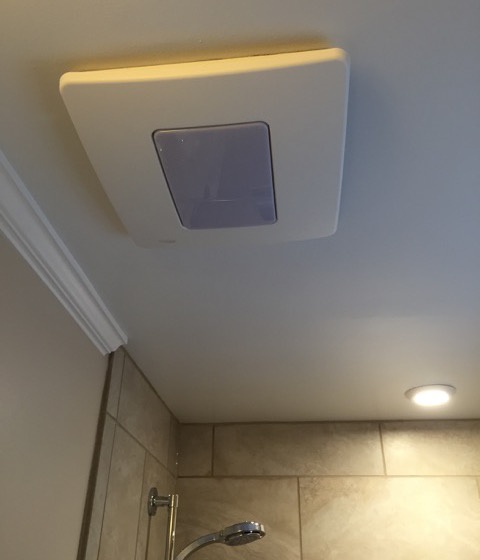
Remember my bathroom remodeling project? I took the liberty of gutting our outdated, decaying bathroom while my wife was out of town in April. I found some interesting air leakage pathways when I opened the walls. I fixed that. I found termite damage. I fixed that. Our 1970 condo didn’t have an exhaust fan in this bathroom because, hey, who needs a bath fan when you have a window! I fixed that. Here’s how.
Bath fans are essential pieces of equipment for homes. They help get rid of moisture. I’ve been tracking temperature and relative humidity in my bathroom for a couple of years now so I’ve seen the difference. The difference with the new exhaust fan is remarkable.
I used a Broan exhaust fan rated at 80 cubic feet per minute (cfm). I know most bath fans don’t get the amount of air flow they’re rated for. Heck, the majority don’t even come close. The typical bath fan gets about half its rated flow. I wanted to make sure this one delivered, and it does.
Break on through to the other side
In an existing home, the first thing you’ve got to do is figure out how you’re going to get the exhaust air to the outdoors. You can’t just dump it in a attic or other buffer space. Since there’s conditioned space above our bathroom (another condo), going through the attic wasn’t an option. I had to go through the band joist.
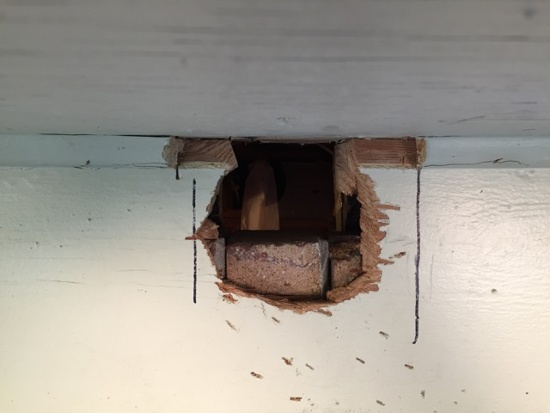
As you can tell from the photo above, making a hole to run the duct through was a major pain. If you’ve ever done this kind of work, you know the origin of those marks below the hole. If not, let me describe the process here.
I had to go through four layers of material in this wall. On the inside, I had to cut through the 2×6 band joist first. Then the Celotex, which was the easiest part. Then brick. Then the 1-by trim board on the outside. The photo above was taken from the outside.
Those marks below the hole are from my reciprocating saw bouncing out occasionally as I cut that hole from the outside. The saw would cut through wood, hit the brick, and then recoil. But I was still pushing so it immediately went back toward the board, and it usually hit below the hole. Hence those marks.
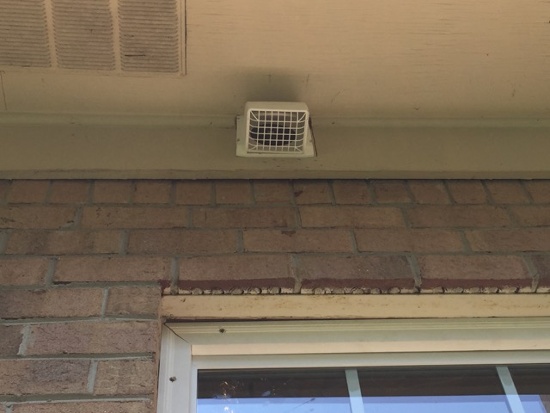
Eventually I got the hole cut, the bricks chiseled out, and the 4″ duct all the way through the hole. It was exhausting work. There’s my wall cap above, shown with the flapper out because the fan was on at the time.
I know what some of you are thinking. Exhausting below the soffit is a terrible idea because moisture-laden air will be drawn back into the soffit through that vent you see. Two things. First, I really had no other choice here. It was either vent there or don’t install a fan. I chose to vent below the soffit. Second, it shouldn’t ever cause a problem. The exit velocity is high enough that the air moves the leaves on the hedges 10 feet below. Little of that air will make its way back to the soffit. It’ll be interesting to see if we get a spot of frost on the hedges on cold winter days.
Preventing backflow
I don’t trust the little flapper on the outside to prevent air from coming back into the house when the fan’s not running. And I certainly didn’t trust the flapper that came inside the fan. That’s a photo of it below. Do you think there might be a little bit of bypass? The flapper didn’t even move when I ran the fan with no duct attached, so I just pulled it out.
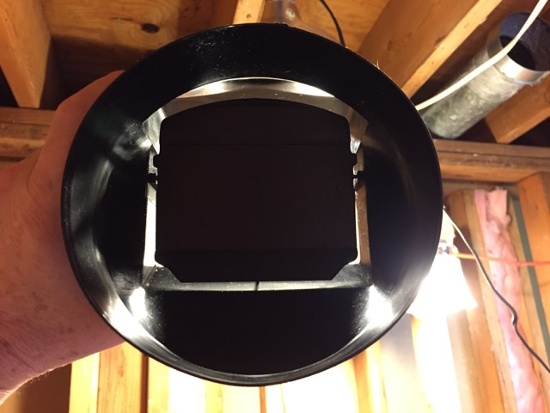
Instead, I installed a Cape Backdraft Damper from Tamarack Technologies. It’s a diode for air flow. Air can flow to the outside because that piece of grey latex see moves with the breeze, like a flag. But if air tries to come back in when the fan is off, that piece of latex falls into the airstream and blocks the flow.
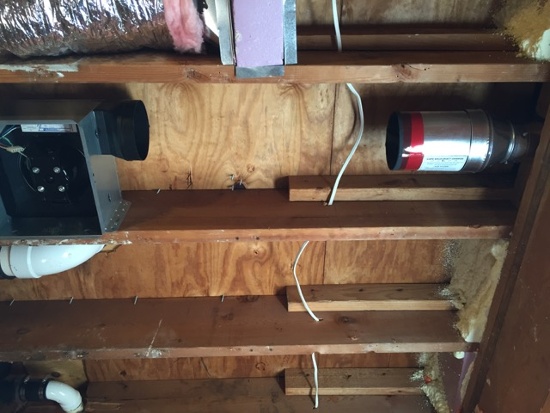
Here’s a photo of the fan on the left and the Cape Damper on the right.
Yes, I used flex duct
The photo below shows the flex duct connecting the fan to the duct that goes out through the wall. It slides right over the Cape Damper. I used zip ties and lots of mastic to hold the duct on and seal it up. In the photo, the left end wasn’t attached yet because I hadn’t installed the insulation jacket over it yet. After I did that, the left side got zipped and sealed, too.
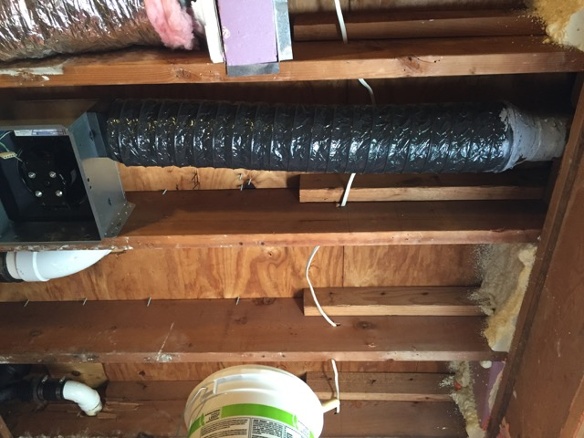
Should I have used rigid metal instead of flex? Some people might think so. I’m confident this duct will last as long as it needs to, though.
How much air does it move?
Of course I tested it for air flow once it was done. I tried it out in different configurations: with the grille on and off, with the window open and closed, and with the bathroom door open and closed. My 80 cfm fan moved an average of 66 cfm during those tests. The range was 50 cfm to 75 cfm, and I don’t completely trust that the 50 cfm was correct. That was with the grille on, and the exhaust fan flow device I used fit tightly over the fan and seemed to be interfering with the flow.
I’ve installed a few exhaust fans in my life. It alway seems like it should be an easy process. Occasionally it is. That wasn’t the case in our bathroom remodel. But it was well worth it.
Other articles in this series
Air Flow Pathways in a Leaky Bathroom Wall
7 Reasons to Gut Your Bathroom When You Remodel
How to Fix a Leaky, Underinsulated Exterior Wall
Related Articles
5 Reasons Bath Fans Have Such Poor Air Flow
This Little Hitch Snares ENERGY STAR Homes
NOTE: Comments are closed.
This Post Has 37 Comments
Comments are closed.

Nice article – thanks. What
Nice article – thanks. What are you going to use to insulate against the interior side of the rim board and around your new duct?
Thanks, Charles. I wrote
Thanks, Charles. I wrote about how I insulated the wall in a previous article, “How to Fix a Leaky, Underinsulated Exterior Wall,” linked above. I used the fiberglass jacket that came with it to insulate the flex duct.
I would not dismiss the 50
I would not dismiss the 50 CFM. There are a couple of issues to keep in mind. Any air direction change reduces flow, as does the flapper, diode, grille and the flex pipe. Air flow is typically (as with gas mileage) in optimum conditions. The vent under the eave would not fly in the north and may be a slow problem as moist air gets sucked up the eave vent.
I concur with Harry. Code
I concur with Harry. Code allows it, but it’s bad practice in a colder climate. But, how is it you have a condo above you and a soffit vent as well? Is it a cantilever vent?
I recently replaced three
I recently replaced three existing exhaust fans in my home with low sone models. The existing fans had been hard piped to a nearby soffit and just dumped into the cavity. Holes were knocked into the soffit in the general area of the pipe termination (not lined up at all) and a stamped-out grille of sorts with virtually no net free area. I streamlined the new pipe all the way to the outside with a proper termination. The fans work great and I get acceptable air flow. Now the only problem is that the terminations for two of them are on the same side of the one story house about 20 feet from my AC condensing unit. The nice clear, efficient ducting now acts like a voice tube on a steamship so when the AC comes on I can hear it through the fan ducts so it sounds like the fans are on! Unintended consequences. At least I won’t have that problem in the winter.
Harry, I’m not completely
Harry, I’m not completely dismissing the 50 cfm measurement. But I am discounting it. The flow device I used had to stretch a bit to fit around the fan grille. I’m pretty sure it impeded the flow. At some point I’ll make or buy a bigger device and get a more accurate measurement. For now, I’m confident I get at least 60 cfm, which is plenty for this small bathroom.
I understand the problem with venting from soffits. It’s not ideal, but here are two things to consider: First, we really had no other choice in this case. Second, I don’t think much of the vented air gets into the soffit. It blows downward with a lot of velocity. I can feel the air blowing when I stand on the ground 10 feet below the outlet.
Good question, Dale. Our
Good question, Dale. Our building has a Mansard roof and the upper floor walls aren’t vertical. So there’s a little bit of soffit.
In case you didn’t see it, I replied to Harry that I don’t think we’ll have a problem here because the air velocity is pretty high when it comes out. It blows the leaves around 10 or 12 feet below.
Yeah, Rob, the same
Yeah, Rob, the same characteristic that makes hardpipe good at transmitting air also makes it good at transmitting sound. But having a little extra white noise in the bathroom isn’t always a bad thing.
Hi Allison, sorry I was not
Hi Allison, sorry I was not clear in my question – I was not asking about insulating the flex duct, rather insulating the rim board where the flex duct passes through the rim board. Will you use a can of store bought insulating/sealing foam or try to fit fiberglass batt to the rim board and cutting a hole in it to fit around the duct?
Ah, I see. I used 2-part
Ah, I see. I used 2-part closed cell spray foam to seal and insulate the penetration. It would be much harder to do it any other way.
A good alternative to the
A good alternative to the reciprocating saw for applications like that is an oscillating tool (Fein tool). Lets you cut in towards the brick instead of parallel to it.
Thanks for the tip, Dan. I’ll
Thanks for the tip, Dan. I’ll have to put that on my list for next time.
I used a 4.5″ hole saw. Gave
I used a 4.5″ hole saw. Gave extra clearance for the vent termination’s collar.
This question goes against
This question goes against the prevailing wisdom but here goes. What are the odds that an exhaust fan in the shower area, removes air with a lower dew point than the outside air which flows in to replace it?
This addresses the common statement that an exhaust fan will reduce humidity in a bathroom.
Good question, Mark. That’s
Good question, Mark. That’s why it’s important to measure. It’s been muggy in Atlanta this summer. Probably not as muggy as Houston, but our dew points have been 70° F and higher almost all summer. So when my fan runs, it pulls in that humid air from outdoors.
When I take a shower and don’t run the fan, the dew point in the bathroom gets up to the mid to upper 70s, a little higher than outdoor dew points this summer. By running the fan, I’m sending more humid air outside and bringing in air that’s a bit drier. At a certain point, though, the net effect is to add to the latent load in the house, not reduce it.
I’ve been monitoring temperature and relative humidity in the bathroom and at the return vent in the living room. Even with the bath fan running past the point of equal dew points, our RH has stayed in the low to mid 50% range all summer. When my filter gets dirty enough to slow the air down more, our RH even drops into the upper 40s.
Great article, all the more
Great article, all the more so because I’ve just replaced the extractor fan in my half bath. Unlike your condo which pre-dated the standard for mandatory installation and therefore you had to start from scratch (kudos due — and you deserve a medal of some sort!) there was on in situ. The problem was, the duct led out to a ventilated void — which also had the top of the soil stack in it! The architect supposed that the void ventilation would suffice for the soil stack. But then the bath installer decided to vent the extraction fan there too.
This was okay, until a breeze blows, straight back through the fan duct and into the space. I replaced the extractor fan with a unit that had a backdraft prevention damper but like you, when I unpacked the unit prior to installation I guessed that, cough, there could be a wee bit if bypassing.
I’ll follow up on the additional measures you mention.
I installed an EBM style
I installed an EBM style backward curved impeller in a reno where the fan was mounted near the roof with duct connecting to the bathroom grill. When the fan was on, you could hear nothing so we had to install a timer on it.
1st the EBM uses a fraction of the power of a shaded pole or even PSC motor.
2nd the fan will run for about 25 years continuously so never needs to be replaced
3rd It is quiet.
I am surprised I don’t see more of these.
Allison, that damper looks
Allison, that damper looks nice but got some pretty mediocre reviews on Amazon. Some folks were complaining that even the stack effect was forcing it open.
Have you checked how it’s doing? Maybe put a piece of paper or a tissue up by the bathroom vent and see if it sticks?
I may have missed it but how
I may have missed it but how do you control your fan?
I went with a wind-up timer that we usually set for 20 minutes when we enter the shower.
Crude, but better than finding the fan on (never by me😄) later in the day.
Interesting proximity of the
Interesting proximity of the discharge to the soffit vent. I am not clear as to what that soffit pertains to since you mentioned that there is no attic above your unit, but if the soffit vent is functioning properly, your exhausted moist air may be heading right back into your structure.
I’m not sure what that
I’m not sure what that ventilated void is, Clive, but it certainly doesn’t sound like a place to vent a soil stack or bath fan.
Colin, I didn’t tell the
Colin, I didn’t tell the story of my fan in the article, but I’ve had it since 2005. It’s moved from place to place with me over the past decade as I’ve waited for the opportunity to use it. I got it for participating in a focus group for Broan at the 2005 Affordable Comfort conference in Indianapolis. It has an electronically commutated motor (ECM).
Rick, are you talking about
Rick, are you talking about the Cape Damper? I haven’t tested it in situ, but I did play around with it before installing it. I haven’t seen a problem.
Good question, Steve. I
Good question, Steve. I should have mentioned that in the article. Right now I’m just using an on/off switch. Soon I’ll install the condensation sensor (by DewStop) and let it operate based on humidity.
Chris, that soffit is on the
Chris, that soffit is on the lower end of the mansard roof, so it’s just a little isolated space. See my replies to Harry Applin and Dale Sherman above about that issue.
My Exhaust nightmare was when
My Exhaust nightmare was when I finally got to the wife’s bathroom exhaust, you know, my house it can wait syndrome, I got really PO’d. Following from the outside in, it came in, had 4″ of flex, and stopped. On the bedroom side there was 14′ of flex to the bathroom wall, and stopped. In the bathroom ceiling the was @ 6-8′ of flex that didn’t go anywhere but to the beam above the ceiling. There was some rage involved in the investigation and some drywall repair needed.
This home is a modular type, pretty large Colonial my wife bought before we met. Some pretty unique ideas in the HVAC dept, not just the bathroom. The combustion air intake for the upstairs furnace came from the wait for it-the plumbing vent pipe. The downstairs furnace flue exhausted into the knee wall attic space of the bonus room above garage.
When it was 1st installed my wife said she had to point out that as far as her limited knowledge of the trade went she still didn’t think air was supposed to come out of the return air grill. Wrong furnace.
Allison, in many
Allison, in many jurisdictions in NC uninsulated bath fan duct won’t fly anymore, but that’s a side observation unrelated to your situation – you’re within thermal envelope, it seems like. Rigid or flex really does not matter for a short run like yours, as long as one does not arrange flex like a small intestine. Although you could’ve stretched out those ribs just a wee bit more.
About getting the cfm’s you deserve, there are exhaust fans that compensate for negative pressure (up to a level).
Can’t tell very well from the photo, but if that’s a reduction from 4″ to 3″ past the cape damper, maybe that’s why you are blowing leaves 10-12′ away!
Nice article. Great to see
Nice article. Great to see that you can do real work Allison. I’ve often used the chart available through this link to discuss the differences in air flow between flex and smooth duct. https://www.bpa.gov/EE/Sectors/Residential/Documents/BPA-W-exhaust-fan-prescriptive-duct-sizing.pdf Compare 4″ smooth and flex at 80 CFM. The difference is staggering.
I’m guessing that you used 4″ flex duct and the length appears to be about 3′. Is that accurate? It also appears that you transition to a smaller diameter fitting for outlet, but that may just be my misinterpretation of the photo.
Regardless, I would always try to use smooth duct when possible to maximize air flow.
I wonder if the “Cape Damper”
I wonder if the “Cape Damper” Allison used would attenuate incoming sound. That would be a nice bonus.
Allison, could you have
Allison, could you have placed the exhaust fan high on the exterior wall when you had the wall opened up? That might have simplified installation. You wouldn’t have to cut through the rim joist. I don’t know why exhaust fans come with such pathetic back flow dampers. It seems out of place in this age of air tight homes. The best exhaust fan I ever used was in my mothers vacation trailer. It was on the wall just above the stove. You pushed a rod that opened a water tight cover on the outside wall. The fan would then start. When you were done, just pull on the rod and the fan would turn off. The thing was air tight, even on the coldest days. Worked for 40+ years.
Sean, To go through the wall
Sean, To go through the wall instead of the band joist, I would have had to put in two 90° elbows and give up more space for insulation. Plus, it would have been more visible on the exterior wall, perhaps bringing me some grief from the homeowners’ association, and it would have meant cutting through more brick.
That fan with the rod sounds like a good way to ensure good air flow. Probably not insulated very well, but with no duct, the air flow must have been close to the rated number.
Sean, yes, I think it
Sean, yes, I think it probably does. As you can see in the 5h photo, it hangs down and blocks most of the duct when the fan’s not on. I haven’t measured sound levels from outdoors with and without it, though.
Armand, Yes, indeed. I’m not
Armand, Yes, indeed. I’m not as good as I was back when I built a house and then was a home performance contractor, but I still know how to do stuff with tools.
Prescriptive charts like the one in your link are good as long as you pay attention to the small print at the bottom. For bath fans, that’s really all you need.
The duct coming off the fan was 6″ and I had to reduce it to 4″ to go through the band joist. That was all the space I had.
Paul, I didn’t show a photo,
Paul, I didn’t show a photo, but I did mention in the article that I insulated the duct. I took the photo you see just to show the flex duct pulled tight. And you’re right. It was pulled tighter once I fastened the left side with the zip tie after sliding the insulation jacket over it.
The duct is 6″ and it reduces to 4″, so that does give it some extra velocity.
Bob, that’s more than just an
Bob, that’s more than just an exhaust nightmare. That house sounds dangerous. Venting a furnace into an attic space? Wow!
Allison, I only provided the
Allison, I only provided the chart to highlight the difference in resistance between the duct types. Using 6 inch duct for a straight run such as yours obviously gives you a huge margin for error. In your case, I may have used 6″ flex as well.
Armand, the nice thing is
Armand, the nice thing is that this fan came with a 6″ takeoff.